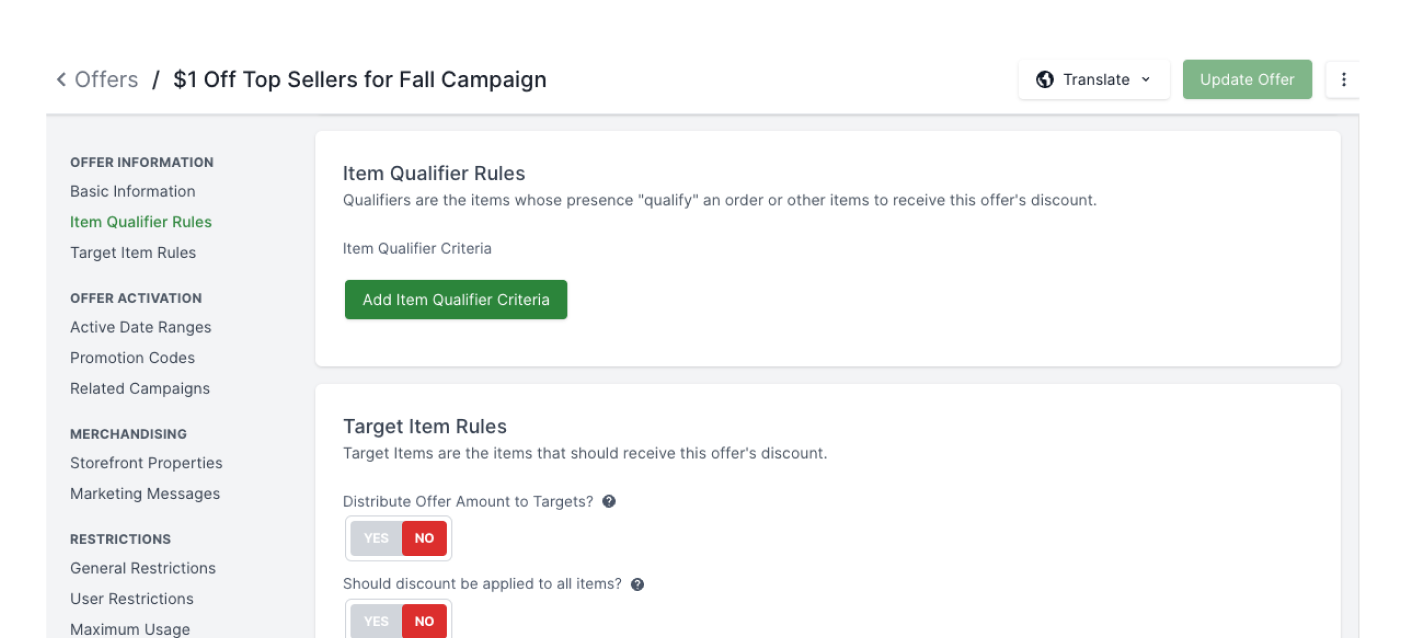Stop Betting Your Business on Big Bang Replatforms
Written by
Broadleaf Commerce
Published on
Sep 16, 2025
Enterprise eCommerce leaders face a familiar dilemma: legacy systems that can't keep pace with business demands, yet the prospect of a complete replatform carries unacceptable risk. After watching dozens of organizations navigate this challenge, we've observed that the most successful modernization efforts don't follow the traditional playbook.
The conventional wisdom of "rip and replace" has become obsolete in today's business environment.
Traditional enterprise replatforms operate on outdated assumptions. They presuppose that modernization requires total system replacement, demanding synchronized migration of all data, integrations, and business logic within compressed timeframes.
Consider the typical enterprise replatform timeline: 6 to 24 months of design, development, migration, integration, and testing, followed by a single high-stakes cutover event. During this period, business innovation effectively stops while engineering resources focus entirely on migration activities. The financial exposure often reaches eight figures, and a single architectural miscalculation can compromise years of investment.
Recent industry analysis shows that 60% of enterprise replatform projects exceed their original timeline by more than six months, while 40% experience budget overruns exceeding 50% of initial estimates. More critically, these projects create extended periods of competitive vulnerability as organizations postpone feature development and market response capabilities.
The Strangler Fig Strategy for Enterprise Systems
Martin Fowler's strangler fig pattern offers a fundamentally different approach, enabling systematic replacement of monolithic systems through incremental substitution, allowing legacy and modern components to coexist during transition periods.
For enterprise commerce environments, it means identifying discrete business capabilities within the monolith and replacing them incrementally with best-of-breed services. The existing system continues operating while new capabilities gradually assume responsibility for specific functions.
This approach aligns with enterprise risk management principles: smaller deployments reduce blast radius, shorter project cycles enable faster value realization, and incremental investments allow for course correction based on actual performance data.
Enterprise Implementation Considerations
Successful implementation of this strategy requires careful evaluation of organizational readiness and technical constraints, including:
- Architectural Prerequisites: Enterprise systems suitable for strangler fig modernization typically exhibit some degree of logical separation between business domains. Even poorly architected monoliths often have identifiable boundaries around catalog management, pricing, inventory, and order processing. The key is finding these seams and exploiting them systematically.
- Operational Complexity Management: During transition periods, enterprises must manage hybrid architectures with components spanning multiple technology stacks. This requires enhanced monitoring capabilities, sophisticated deployment pipelines, and teams capable of supporting both legacy and modern systems simultaneously.
- Data Management: Data consistency becomes particularly challenging in enterprise environments with high transaction volumes and complex business rules. Organizations need robust event streaming infrastructure, comprehensive data validation processes, and clearly defined rollback procedures.
- Organizational Change Requirements: Technical modernization at enterprise scale demands corresponding organizational evolution. Traditional siloed teams must adapt to cross-functional models capable of owning entire business capabilities. DevOps practices become essential for managing independent service deployments, and incident response procedures must account for distributed system complexities.
Contemporary commerce platforms are architected specifically to support incremental adoption strategies. Rather than monolithic applications, they comprise collections of focused microservices designed for independent deployment and operation.
Broadleaf exemplifies this approach with over 30 discrete services covering capabilities from catalog management and search to pricing and order processing. Each service exposes well-defined APIs and can be deployed independently or as part of a larger platform deployment.
Similar architectural principles apply across the modern commerce landscape, including platforms like commercetools, Elastic Path, and custom microservices implementations. The critical factor is selecting services that don't assume ownership of your entire commerce architecture.
Practical Implementation: Enterprise Search Modernization
Let's examine how this strategy applies to a common enterprise pain point: product search and merchandising capabilities.
Take the example of a global manufacturing company who operates a complex B2B commerce platform serving thousands of industrial customers. Their existing search functionality, built on a custom Solr implementation from 2018, struggled with the company's expanding catalog of 2.3 million SKUs and increasingly sophisticated customer requirements.
A traditional replatform would require migrating the entire commerce stack to support modern search capabilities. Instead, the organization implemented a strangler fig approach:
Phase One: Parallel System Deployment. New search and indexing services were deployed alongside the existing platform without customer-facing changes. The modern system began building product indexes using the same data sources as the legacy search, allowing for performance comparison and feature development without business risk.
Phase Two: Controlled Traffic Migration. Traffic routing logic enabled the gradual migration of search queries to the modern system. The initial deployment handled 5% of search traffic, focusing on specific product categories where improvements could be measured clearly. Performance metrics, relevance scoring, and conversion rates were monitored continuously.
Phase Three: Full Migration and Legacy Retirement. After validating performance across all traffic patterns, the modern search system assumed responsibility for 100% of search queries. Legacy search infrastructure was decommissioned, reducing operational overhead while delivering measurable improvements in search relevance and customer experience.
The entire project required four months from initial deployment to legacy retirement. Business operations continued normally throughout the transition, and the success metrics justified investment in subsequent modernization phases.
Managing Enterprise-Scale Complexity
Large-scale implementations introduce complexities that smaller organizations rarely encounter, such as:
- Data Architecture Challenges: Enterprise systems often contain decades of accumulated data with complex interdependencies. Customer records, order history, product catalogs, and pricing information may span multiple databases with inconsistent schemas and varying data quality standards.
- Inter-system Data Dependencies: Successful strangler fig implementations require comprehensive data mapping exercises to identify dependencies and design appropriate synchronization strategies. This often involves implementing event-driven architectures to maintain consistency between old and new systems during transition periods.
- Integration Ecosystem Considerations: Enterprise commerce platforms rarely operate in isolation. They integrate with ERP systems, CRM platforms, supply chain management tools, financial systems, and numerous third-party services. Each modernization phase must account for these integration points and ensure compatibility across the entire ecosystem.
- Performance and Scale Requirements: Enterprise platforms must handle significant transaction volumes, often with strict performance requirements and minimal acceptable downtime. Hybrid architectures can introduce additional latency through cross-system API calls, requiring careful optimization and performance testing throughout the migration process.
Business Value Realization
The strangler fig approach delivers enterprise value through several distinct mechanisms, including:
- Risk Mitigation: By limiting the scope of individual migration phases, organizations dramatically reduce the probability of catastrophic project failure. Each component replacement represents a smaller investment with clearer success criteria and faster feedback cycles.
- Accelerated Innovation: Rather than freezing feature development during lengthy replatform projects, organizations can continue delivering business value throughout the modernization process. New capabilities can be implemented using modern architecture while legacy systems handle existing functionality.
- Financial Flexibility: Incremental modernization enables organizations to spread investment across multiple budget cycles while demonstrating return on investment at each phase. This approach often secures more consistent funding support than large capital expenditure requests for full replatform projects.
- Competitive Advantage: Maintenance Organizations can respond to market opportunities and competitive threats without waiting for complete platform modernization. Critical business capabilities can be prioritized based on strategic importance rather than technical dependencies.
Strategic Implementation and Long-term Benefits
Enterprise organizations must approach modernization with clear frameworks that deliver both immediate value and sustained competitive advantage.
Assessment and Planning Foundation
The modernization process begins with a comprehensive assessment of current capabilities. This assessment should evaluate technical debt accumulation, integration complexity, and the effort required for replacement or modernization.
High-impact capabilities with lower replacement complexity typically provide optimal starting points. Search functionality, for example, often delivers immediate customer experience improvements while requiring minimal integration with core transactional systems. Conversely, order management systems may offer significant business value but involve complex dependencies that increase implementation risk.
The assessment phase must also evaluate organizational readiness. Teams need sufficient expertise in modern architecture patterns, API integration strategies, and distributed systems management. Organizations lacking these capabilities should invest in skill development or partner resources before beginning major modernization initiatives.
Service Selection and Architecture Decisions
Each modernization phase requires careful evaluation of replacement technologies and vendor relationships. Technical compatibility represents just one dimension of the selection process. Organizations must consider scalability characteristics, integration capabilities, vendor stability, and long-term roadmap alignment.
Vendor evaluation should include assessment of their enterprise support capabilities, professional services offerings, and commitment to backward compatibility during platform evolution. Organizations implementing strangler fig strategies need partners that understand the complexities of hybrid environments and can provide expertise throughout extended transition periods.
Execution Excellence and Risk Management
Successful implementation requires detailed migration planning that accounts for data synchronization requirements, performance validation procedures, and comprehensive rollback strategies. Testing becomes exponentially more complex in hybrid environments where failures can cascade across multiple systems with different failure modes and recovery procedures.
Organizations must establish clear success metrics before beginning each phase. Business metrics such as conversion rate improvements, customer satisfaction scores, and revenue per visitor should be tracked alongside technical performance indicators. These measurements provide an objective assessment of modernization value and inform prioritization decisions for subsequent phases.
Risk mitigation strategies must address both technical and business continuity concerns. This includes establishing parallel processing capabilities during transitions, implementing comprehensive monitoring across hybrid architectures, and maintaining detailed incident response procedures that account for the complexity of multi-system environments.
Institutional Knowledge and Cultural Evolution
The strangler fig approach delivers strategic benefits that extend far beyond immediate technical improvements. Organizations develop deep institutional knowledge about modern architecture patterns through practical implementation rather than theoretical training. This expertise becomes increasingly valuable as technology landscapes continue evolving and new business requirements emerge.
Teams gain hands-on experience with distributed systems, API integration strategies, cloud-native development practices, and microservices management. This knowledge accumulation creates organizational capabilities that support continued innovation and adaptation to changing market conditions.
More importantly, successful incremental modernization fundamentally changes organizational culture around technology evolution. Instead of viewing modernization as periodic crisis management, organizations develop continuous improvement mindsets that treat technology advancement as an ongoing competitive capability.
This cultural shift proves invaluable when new technologies emerge or business requirements evolve. Organizations with established incremental modernization capabilities can evaluate and integrate new solutions more rapidly than competitors dependent on large-scale transformation projects.
Sustained Competitive Advantage
The long-term strategic value of strangler fig modernization lies in creating organizational agility that supports sustained competitive advantage. Organizations master the ability to evolve their technology infrastructure continuously while maintaining operational stability and business growth.
This capability becomes increasingly important as market conditions change more rapidly and customer expectations continue evolving. Organizations that can integrate new capabilities quickly while maintaining system reliability gain significant advantages over competitors locked into rigid monolithic architectures or dependent on disruptive replatform cycles.
The financial benefits compound over time as well. Organizations avoid the large capital expenditures associated with periodic replatforms while gaining the ability to optimize technology investments based on demonstrated business value rather than theoretical projections.
Conclusion
Enterprise eCommerce modernization doesn't require betting the entire organization on a single massive project. The strangler fig pattern, enabled by modern composable commerce platforms, provides a proven alternative that manages risk while delivering measurable business value.
The key insight is recognizing that perfect architectures don't exist, but continuously improving architectures can provide a sustainable competitive advantage. By replacing the weakest components first and building momentum through demonstrated success, organizations can achieve comprehensive modernization without the existential risks of traditional replatform approaches.
This strategy demands discipline, technical expertise, and organizational commitment to managing temporary complexity. However, the alternative of maintaining legacy systems indefinitely or risking everything on big bang modernization projects has become untenable in today's competitive environment.
The most successful enterprises will be those that master continuous evolution, treating modernization as an ongoing capability rather than a periodic crisis.




